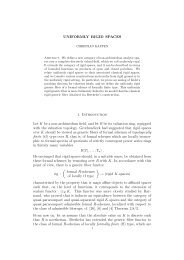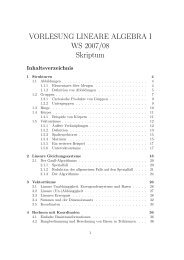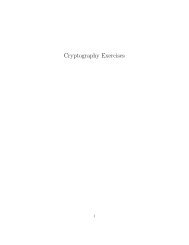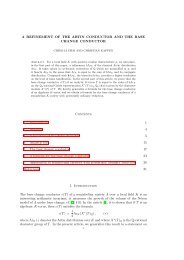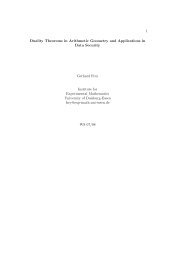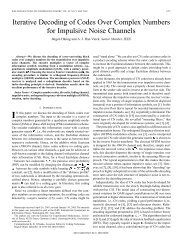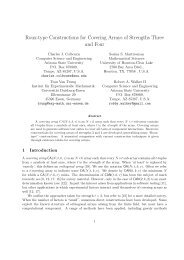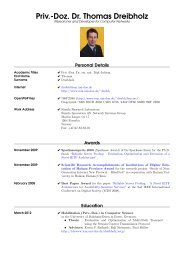Products of CM elliptic curves - Universität Duisburg-Essen
Products of CM elliptic curves - Universität Duisburg-Essen
Products of CM elliptic curves - Universität Duisburg-Essen
You also want an ePaper? Increase the reach of your titles
YUMPU automatically turns print PDFs into web optimized ePapers that Google loves.
(a) The order R is cyclic if and only if for all n ≥ 1 we have that every R-submodule<strong>of</strong> R n is isomorphic to a direct sum <strong>of</strong> R-ideals.(b) Let R be a cyclic order, and let M be an R-submodule <strong>of</strong> R n <strong>of</strong> rank n. Thenthere exist R-ideals I 1 , . . . , I n such that(89)M ≃ I 1 ⊕ . . . ⊕ I n and R(I 1 ) ⊂ R(I 2 ) ⊂ . . . R(I n ),and the orders R(I 1 ) ⊂ . . . ⊂ R(I n ) and the ideal class <strong>of</strong> the product I 1 · · · I n areuniquely determined by the isomorphism class <strong>of</strong> M. More precisely, if J 1 , . . . , J m areR-ideals with R(J 1 ) ⊂ . . . ⊂ R(J m ), then we have(90)I 1 ⊕ . . . ⊕ I n ≃ J 1 ⊕ . . . ⊕ J m ⇔ n = m and R(I k ) = R(J k ), for 1 ≤ k ≤ n,and I 1 · · · I n ≃ J 1 · · · J m .Pro<strong>of</strong>. (a) This is the main theorem <strong>of</strong> Borevich/Faddeev[2].(b) The existence <strong>of</strong> the I 1 , . . . , I n satisfying (89) is proven in [1], Theorem 3.The uniqueness <strong>of</strong> the orders R(I 1 ), . . . , R(I n ) and <strong>of</strong> the product I 1 · · · I n is proven inTheorems 5 and 6 <strong>of</strong> [1], and the assertion (90) is the content <strong>of</strong> [1], Theorem 7.Remark 46 (a) Since a Dedekind domain is trivially a cyclic order (in itself), it clearthat Theorem 45 generalizes Theorem 44.(b) Every order R ∆ = Z + Zω ∆ in a quadratic field F = Q( √ ∆) is cyclic becauseO F = Z + Zω F = R ∆ + R ∆ ω F . Thus, Theorem 45(b) applies to all orders in quadraticfields.(c) It follows from the above Theorem 45 (cf. [1], Theorem 8) that the rule(R 1 , . . . , R n ; I) ↦→ R 1 ⊕ . . . ⊕ R n−1 ⊕ Iinduces a bijection between the following sets:(i) the set <strong>of</strong> lists (R 1 , . . . , R n ; I) where R ⊂ R 1 ⊂ . . . ⊂ R n ⊂ O Fcontaining R and I ∈ Pic(R n ) is a class <strong>of</strong> invertible R n -ideals;are orders(ii) the set <strong>of</strong> isomorphism classes <strong>of</strong> finitely generated torsion-free R-modules <strong>of</strong>rank n.Corollary 47 Let V be an n-dimensional F -vector space, where F ⊃ Q is a quadraticfield, and let L be a lattice in V , i.e. L ⊂ V is a finitely generated subgroup whichcontains a basis <strong>of</strong> V . Then R F (L) := (L : L) F = {x ∈ F : xL ⊂ L} is an order<strong>of</strong> F , and L is an R F (L)-module. Furthermore, there exists a sequence <strong>of</strong> ordersR 1 = R F (L) ⊂ R 2 ⊂ . . . ⊂ R n , an invertible R n -ideal I and a basis x 1 , . . . , x n <strong>of</strong> Vsuch that(91)L = R 1 x 1 + R 2 x 2 + . . . + R n−1 x n−1 + Ix n .37



